Accounting Report: Conceptual Framework and Valuation Methods
VerifiedAdded on 2022/09/09
|9
|2104
|18
Report
AI Summary
This report delves into core accounting principles, starting with the concept of faithful representation, emphasizing its role in accurately reflecting a business's financial position through completeness, error-free information, and unbiasedness. It then explores the conceptual framework of the AASB, highlighting its importance in developing consistent accounting policies, especially where standards are absent or offer choices, ensuring qualitative aspects like faithful representation and neutrality. The report then contrasts historical costing, which uses transaction prices, with fair value accounting, which reflects current market values. Historical costing is shown to be simpler to compute but may not always provide relevant information due to its failure to consider market changes, particularly for long-term assets. Fair value accounting is presented as a superior method, offering greater transparency and a more accurate reflection of an asset's value based on current market conditions, including time value of money and market participant interactions. The report concludes that fair value accounting is becoming more relevant due to its ability to measure market changes and provide more consistent information for business decisions.
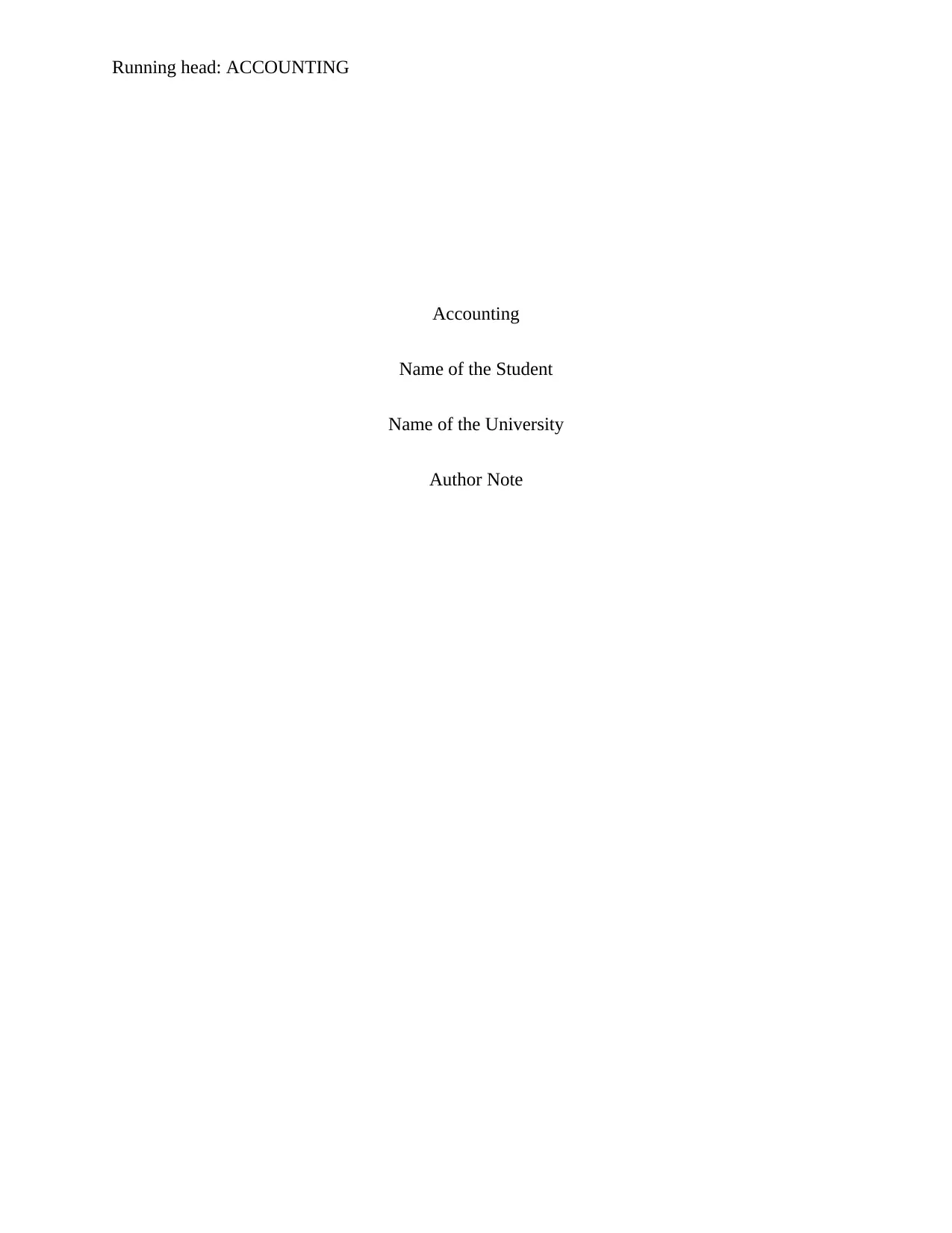
Running head: ACCOUNTING
Accounting
Name of the Student
Name of the University
Author Note
Accounting
Name of the Student
Name of the University
Author Note
Paraphrase This Document
Need a fresh take? Get an instant paraphrase of this document with our AI Paraphraser
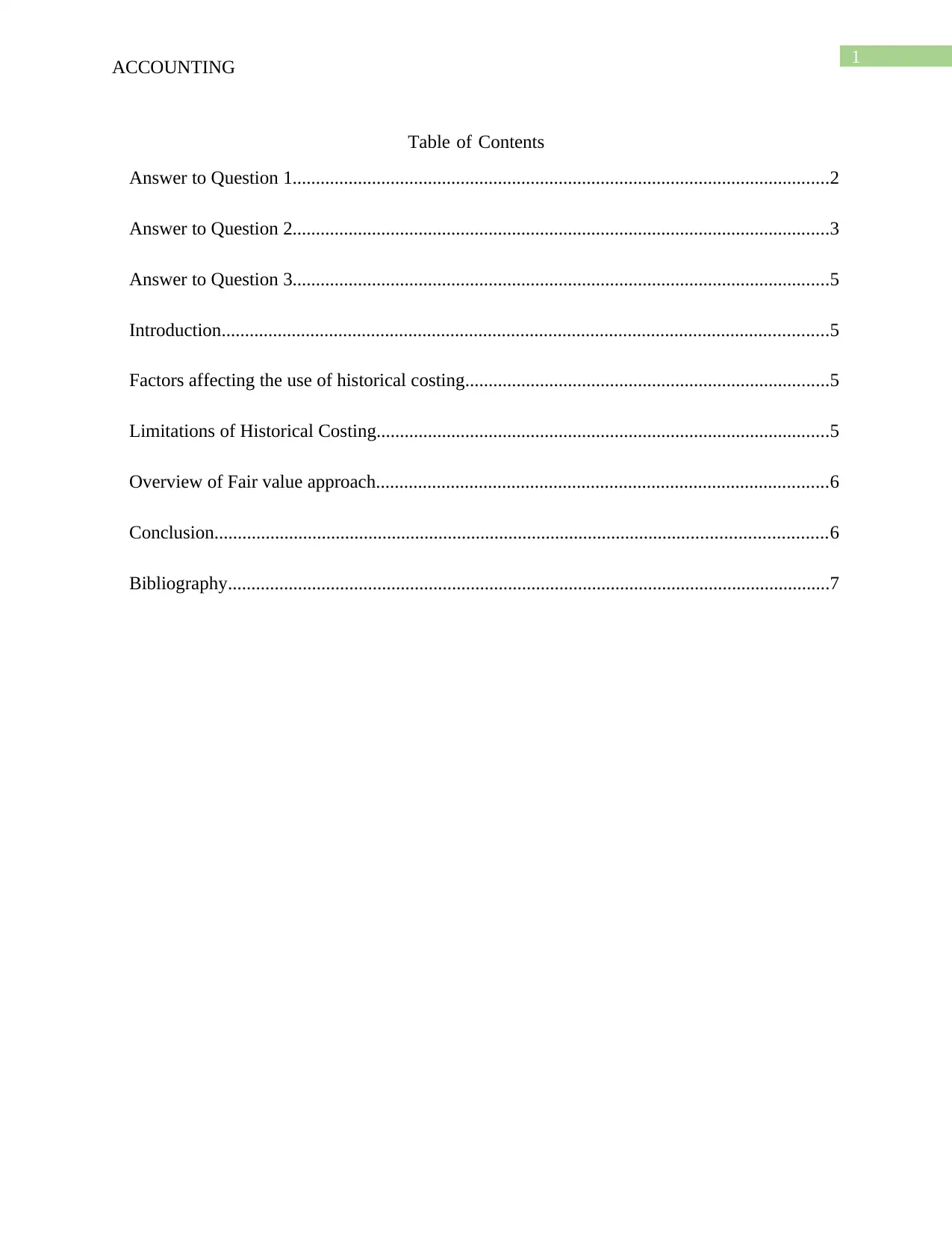
1
ACCOUNTING
Table of Contents
Answer to Question 1...................................................................................................................2
Answer to Question 2...................................................................................................................3
Answer to Question 3...................................................................................................................5
Introduction..................................................................................................................................5
Factors affecting the use of historical costing..............................................................................5
Limitations of Historical Costing.................................................................................................5
Overview of Fair value approach.................................................................................................6
Conclusion...................................................................................................................................6
Bibliography.................................................................................................................................7
ACCOUNTING
Table of Contents
Answer to Question 1...................................................................................................................2
Answer to Question 2...................................................................................................................3
Answer to Question 3...................................................................................................................5
Introduction..................................................................................................................................5
Factors affecting the use of historical costing..............................................................................5
Limitations of Historical Costing.................................................................................................5
Overview of Fair value approach.................................................................................................6
Conclusion...................................................................................................................................6
Bibliography.................................................................................................................................7
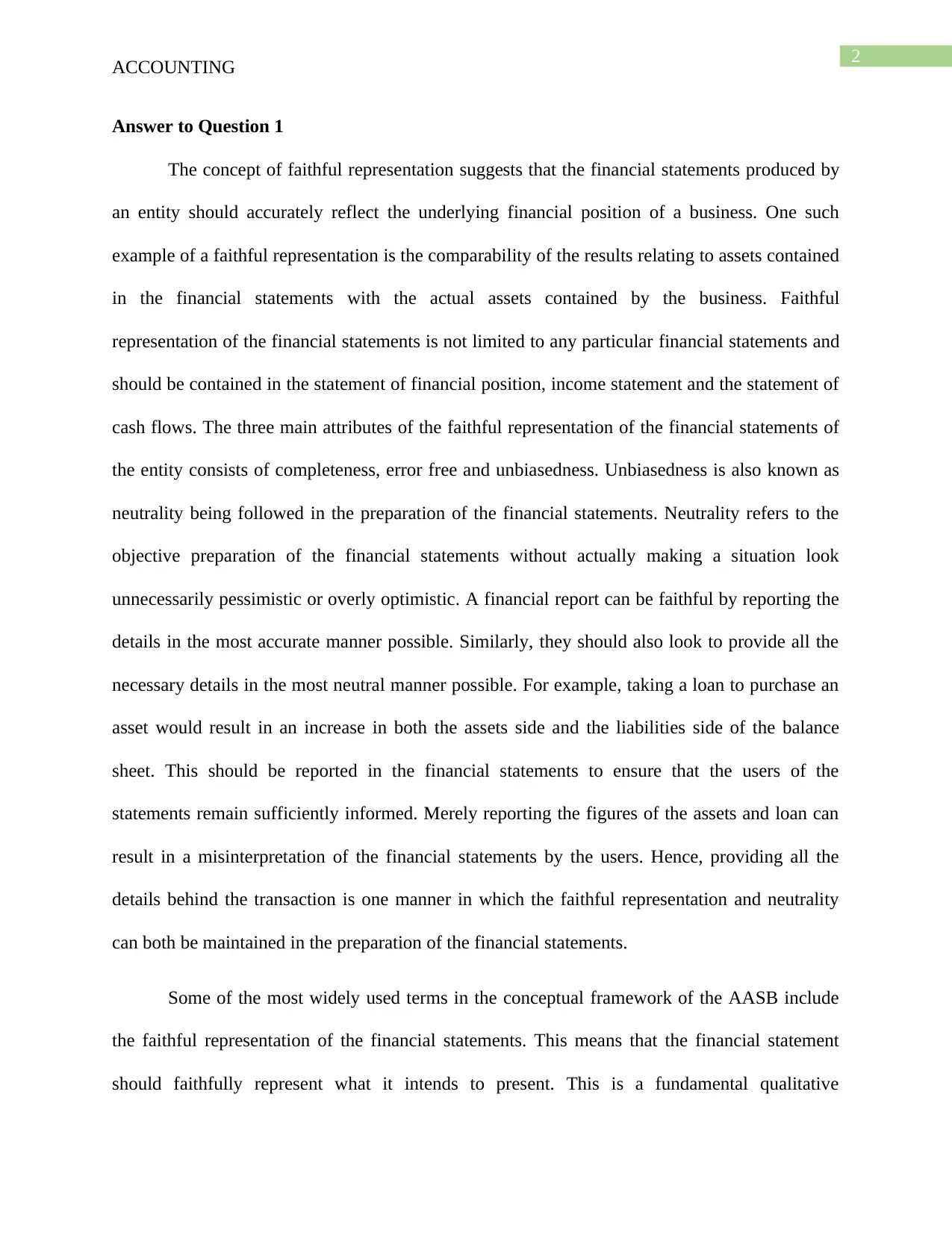
2
ACCOUNTING
Answer to Question 1
The concept of faithful representation suggests that the financial statements produced by
an entity should accurately reflect the underlying financial position of a business. One such
example of a faithful representation is the comparability of the results relating to assets contained
in the financial statements with the actual assets contained by the business. Faithful
representation of the financial statements is not limited to any particular financial statements and
should be contained in the statement of financial position, income statement and the statement of
cash flows. The three main attributes of the faithful representation of the financial statements of
the entity consists of completeness, error free and unbiasedness. Unbiasedness is also known as
neutrality being followed in the preparation of the financial statements. Neutrality refers to the
objective preparation of the financial statements without actually making a situation look
unnecessarily pessimistic or overly optimistic. A financial report can be faithful by reporting the
details in the most accurate manner possible. Similarly, they should also look to provide all the
necessary details in the most neutral manner possible. For example, taking a loan to purchase an
asset would result in an increase in both the assets side and the liabilities side of the balance
sheet. This should be reported in the financial statements to ensure that the users of the
statements remain sufficiently informed. Merely reporting the figures of the assets and loan can
result in a misinterpretation of the financial statements by the users. Hence, providing all the
details behind the transaction is one manner in which the faithful representation and neutrality
can both be maintained in the preparation of the financial statements.
Some of the most widely used terms in the conceptual framework of the AASB include
the faithful representation of the financial statements. This means that the financial statement
should faithfully represent what it intends to present. This is a fundamental qualitative
ACCOUNTING
Answer to Question 1
The concept of faithful representation suggests that the financial statements produced by
an entity should accurately reflect the underlying financial position of a business. One such
example of a faithful representation is the comparability of the results relating to assets contained
in the financial statements with the actual assets contained by the business. Faithful
representation of the financial statements is not limited to any particular financial statements and
should be contained in the statement of financial position, income statement and the statement of
cash flows. The three main attributes of the faithful representation of the financial statements of
the entity consists of completeness, error free and unbiasedness. Unbiasedness is also known as
neutrality being followed in the preparation of the financial statements. Neutrality refers to the
objective preparation of the financial statements without actually making a situation look
unnecessarily pessimistic or overly optimistic. A financial report can be faithful by reporting the
details in the most accurate manner possible. Similarly, they should also look to provide all the
necessary details in the most neutral manner possible. For example, taking a loan to purchase an
asset would result in an increase in both the assets side and the liabilities side of the balance
sheet. This should be reported in the financial statements to ensure that the users of the
statements remain sufficiently informed. Merely reporting the figures of the assets and loan can
result in a misinterpretation of the financial statements by the users. Hence, providing all the
details behind the transaction is one manner in which the faithful representation and neutrality
can both be maintained in the preparation of the financial statements.
Some of the most widely used terms in the conceptual framework of the AASB include
the faithful representation of the financial statements. This means that the financial statement
should faithfully represent what it intends to present. This is a fundamental qualitative
⊘ This is a preview!⊘
Do you want full access?
Subscribe today to unlock all pages.

Trusted by 1+ million students worldwide
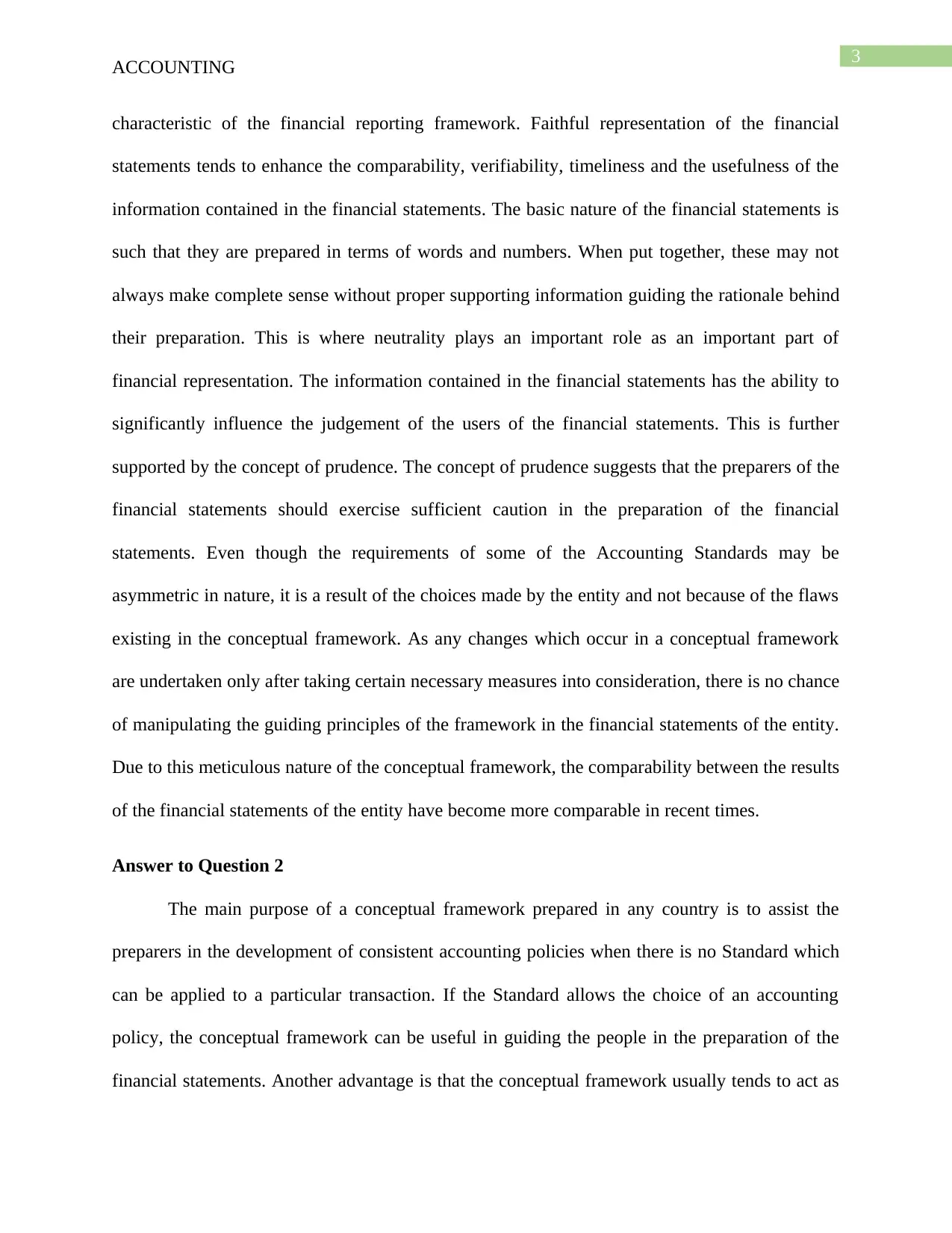
3
ACCOUNTING
characteristic of the financial reporting framework. Faithful representation of the financial
statements tends to enhance the comparability, verifiability, timeliness and the usefulness of the
information contained in the financial statements. The basic nature of the financial statements is
such that they are prepared in terms of words and numbers. When put together, these may not
always make complete sense without proper supporting information guiding the rationale behind
their preparation. This is where neutrality plays an important role as an important part of
financial representation. The information contained in the financial statements has the ability to
significantly influence the judgement of the users of the financial statements. This is further
supported by the concept of prudence. The concept of prudence suggests that the preparers of the
financial statements should exercise sufficient caution in the preparation of the financial
statements. Even though the requirements of some of the Accounting Standards may be
asymmetric in nature, it is a result of the choices made by the entity and not because of the flaws
existing in the conceptual framework. As any changes which occur in a conceptual framework
are undertaken only after taking certain necessary measures into consideration, there is no chance
of manipulating the guiding principles of the framework in the financial statements of the entity.
Due to this meticulous nature of the conceptual framework, the comparability between the results
of the financial statements of the entity have become more comparable in recent times.
Answer to Question 2
The main purpose of a conceptual framework prepared in any country is to assist the
preparers in the development of consistent accounting policies when there is no Standard which
can be applied to a particular transaction. If the Standard allows the choice of an accounting
policy, the conceptual framework can be useful in guiding the people in the preparation of the
financial statements. Another advantage is that the conceptual framework usually tends to act as
ACCOUNTING
characteristic of the financial reporting framework. Faithful representation of the financial
statements tends to enhance the comparability, verifiability, timeliness and the usefulness of the
information contained in the financial statements. The basic nature of the financial statements is
such that they are prepared in terms of words and numbers. When put together, these may not
always make complete sense without proper supporting information guiding the rationale behind
their preparation. This is where neutrality plays an important role as an important part of
financial representation. The information contained in the financial statements has the ability to
significantly influence the judgement of the users of the financial statements. This is further
supported by the concept of prudence. The concept of prudence suggests that the preparers of the
financial statements should exercise sufficient caution in the preparation of the financial
statements. Even though the requirements of some of the Accounting Standards may be
asymmetric in nature, it is a result of the choices made by the entity and not because of the flaws
existing in the conceptual framework. As any changes which occur in a conceptual framework
are undertaken only after taking certain necessary measures into consideration, there is no chance
of manipulating the guiding principles of the framework in the financial statements of the entity.
Due to this meticulous nature of the conceptual framework, the comparability between the results
of the financial statements of the entity have become more comparable in recent times.
Answer to Question 2
The main purpose of a conceptual framework prepared in any country is to assist the
preparers in the development of consistent accounting policies when there is no Standard which
can be applied to a particular transaction. If the Standard allows the choice of an accounting
policy, the conceptual framework can be useful in guiding the people in the preparation of the
financial statements. Another advantage is that the conceptual framework usually tends to act as
Paraphrase This Document
Need a fresh take? Get an instant paraphrase of this document with our AI Paraphraser
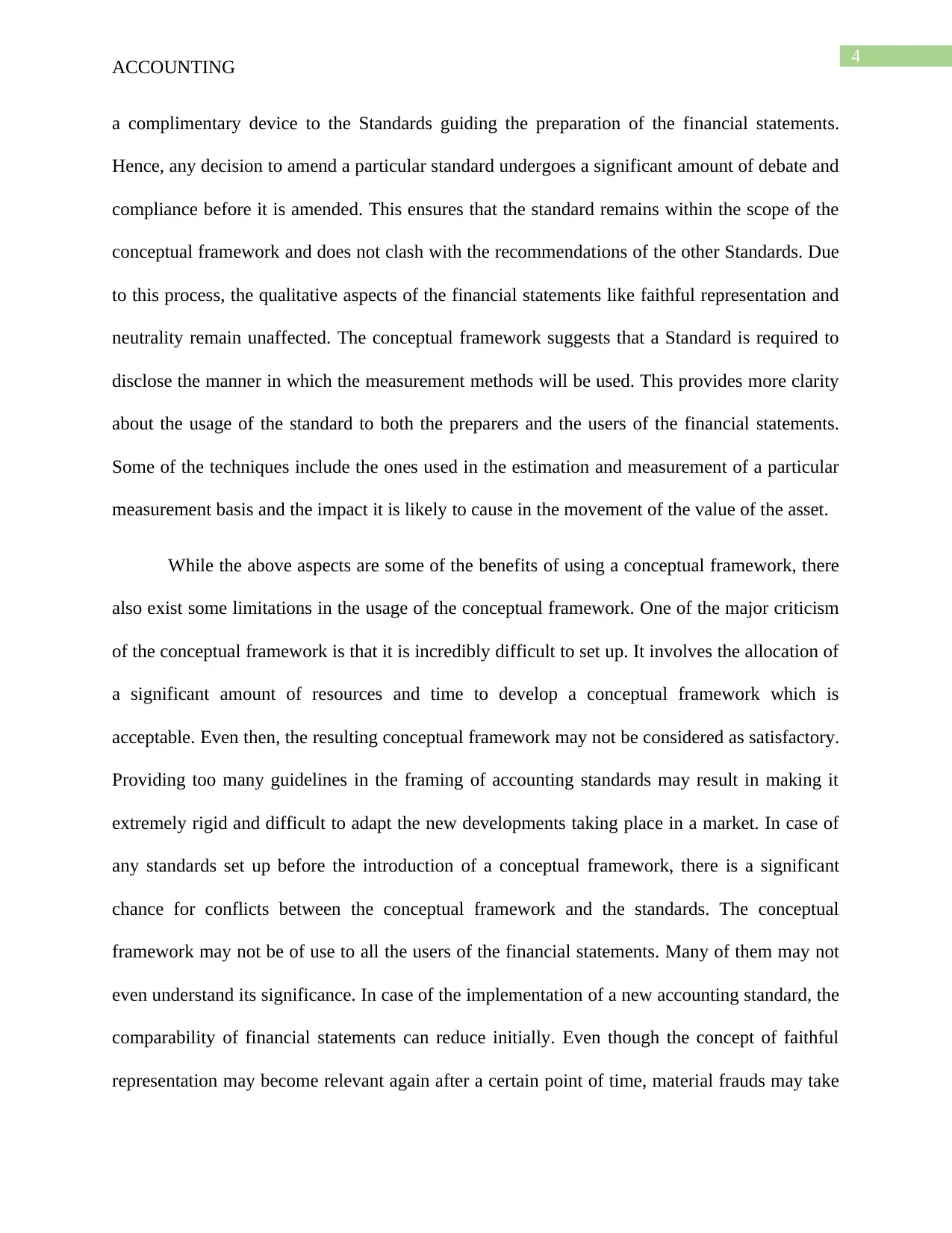
4
ACCOUNTING
a complimentary device to the Standards guiding the preparation of the financial statements.
Hence, any decision to amend a particular standard undergoes a significant amount of debate and
compliance before it is amended. This ensures that the standard remains within the scope of the
conceptual framework and does not clash with the recommendations of the other Standards. Due
to this process, the qualitative aspects of the financial statements like faithful representation and
neutrality remain unaffected. The conceptual framework suggests that a Standard is required to
disclose the manner in which the measurement methods will be used. This provides more clarity
about the usage of the standard to both the preparers and the users of the financial statements.
Some of the techniques include the ones used in the estimation and measurement of a particular
measurement basis and the impact it is likely to cause in the movement of the value of the asset.
While the above aspects are some of the benefits of using a conceptual framework, there
also exist some limitations in the usage of the conceptual framework. One of the major criticism
of the conceptual framework is that it is incredibly difficult to set up. It involves the allocation of
a significant amount of resources and time to develop a conceptual framework which is
acceptable. Even then, the resulting conceptual framework may not be considered as satisfactory.
Providing too many guidelines in the framing of accounting standards may result in making it
extremely rigid and difficult to adapt the new developments taking place in a market. In case of
any standards set up before the introduction of a conceptual framework, there is a significant
chance for conflicts between the conceptual framework and the standards. The conceptual
framework may not be of use to all the users of the financial statements. Many of them may not
even understand its significance. In case of the implementation of a new accounting standard, the
comparability of financial statements can reduce initially. Even though the concept of faithful
representation may become relevant again after a certain point of time, material frauds may take
ACCOUNTING
a complimentary device to the Standards guiding the preparation of the financial statements.
Hence, any decision to amend a particular standard undergoes a significant amount of debate and
compliance before it is amended. This ensures that the standard remains within the scope of the
conceptual framework and does not clash with the recommendations of the other Standards. Due
to this process, the qualitative aspects of the financial statements like faithful representation and
neutrality remain unaffected. The conceptual framework suggests that a Standard is required to
disclose the manner in which the measurement methods will be used. This provides more clarity
about the usage of the standard to both the preparers and the users of the financial statements.
Some of the techniques include the ones used in the estimation and measurement of a particular
measurement basis and the impact it is likely to cause in the movement of the value of the asset.
While the above aspects are some of the benefits of using a conceptual framework, there
also exist some limitations in the usage of the conceptual framework. One of the major criticism
of the conceptual framework is that it is incredibly difficult to set up. It involves the allocation of
a significant amount of resources and time to develop a conceptual framework which is
acceptable. Even then, the resulting conceptual framework may not be considered as satisfactory.
Providing too many guidelines in the framing of accounting standards may result in making it
extremely rigid and difficult to adapt the new developments taking place in a market. In case of
any standards set up before the introduction of a conceptual framework, there is a significant
chance for conflicts between the conceptual framework and the standards. The conceptual
framework may not be of use to all the users of the financial statements. Many of them may not
even understand its significance. In case of the implementation of a new accounting standard, the
comparability of financial statements can reduce initially. Even though the concept of faithful
representation may become relevant again after a certain point of time, material frauds may take
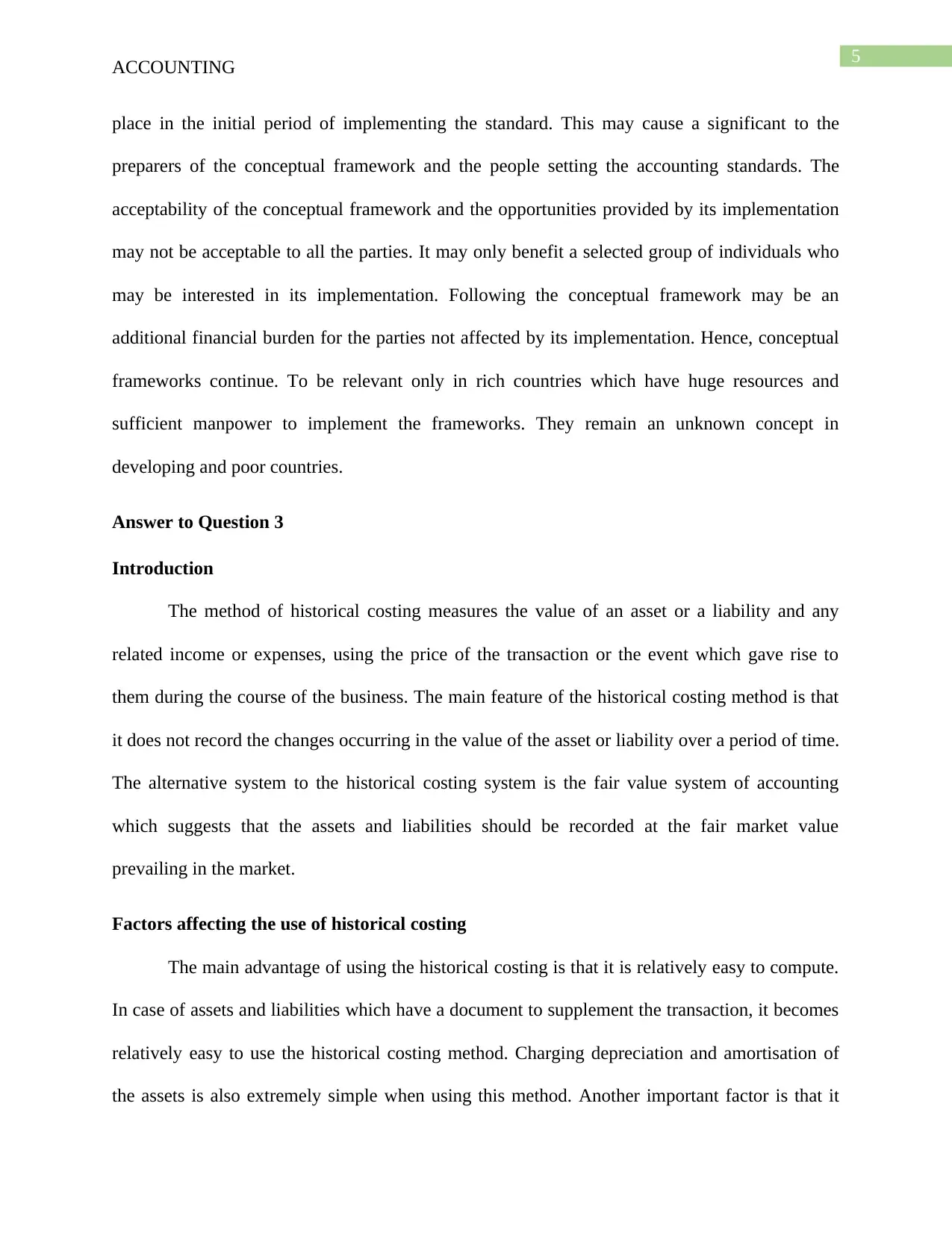
5
ACCOUNTING
place in the initial period of implementing the standard. This may cause a significant to the
preparers of the conceptual framework and the people setting the accounting standards. The
acceptability of the conceptual framework and the opportunities provided by its implementation
may not be acceptable to all the parties. It may only benefit a selected group of individuals who
may be interested in its implementation. Following the conceptual framework may be an
additional financial burden for the parties not affected by its implementation. Hence, conceptual
frameworks continue. To be relevant only in rich countries which have huge resources and
sufficient manpower to implement the frameworks. They remain an unknown concept in
developing and poor countries.
Answer to Question 3
Introduction
The method of historical costing measures the value of an asset or a liability and any
related income or expenses, using the price of the transaction or the event which gave rise to
them during the course of the business. The main feature of the historical costing method is that
it does not record the changes occurring in the value of the asset or liability over a period of time.
The alternative system to the historical costing system is the fair value system of accounting
which suggests that the assets and liabilities should be recorded at the fair market value
prevailing in the market.
Factors affecting the use of historical costing
The main advantage of using the historical costing is that it is relatively easy to compute.
In case of assets and liabilities which have a document to supplement the transaction, it becomes
relatively easy to use the historical costing method. Charging depreciation and amortisation of
the assets is also extremely simple when using this method. Another important factor is that it
ACCOUNTING
place in the initial period of implementing the standard. This may cause a significant to the
preparers of the conceptual framework and the people setting the accounting standards. The
acceptability of the conceptual framework and the opportunities provided by its implementation
may not be acceptable to all the parties. It may only benefit a selected group of individuals who
may be interested in its implementation. Following the conceptual framework may be an
additional financial burden for the parties not affected by its implementation. Hence, conceptual
frameworks continue. To be relevant only in rich countries which have huge resources and
sufficient manpower to implement the frameworks. They remain an unknown concept in
developing and poor countries.
Answer to Question 3
Introduction
The method of historical costing measures the value of an asset or a liability and any
related income or expenses, using the price of the transaction or the event which gave rise to
them during the course of the business. The main feature of the historical costing method is that
it does not record the changes occurring in the value of the asset or liability over a period of time.
The alternative system to the historical costing system is the fair value system of accounting
which suggests that the assets and liabilities should be recorded at the fair market value
prevailing in the market.
Factors affecting the use of historical costing
The main advantage of using the historical costing is that it is relatively easy to compute.
In case of assets and liabilities which have a document to supplement the transaction, it becomes
relatively easy to use the historical costing method. Charging depreciation and amortisation of
the assets is also extremely simple when using this method. Another important factor is that it
⊘ This is a preview!⊘
Do you want full access?
Subscribe today to unlock all pages.

Trusted by 1+ million students worldwide
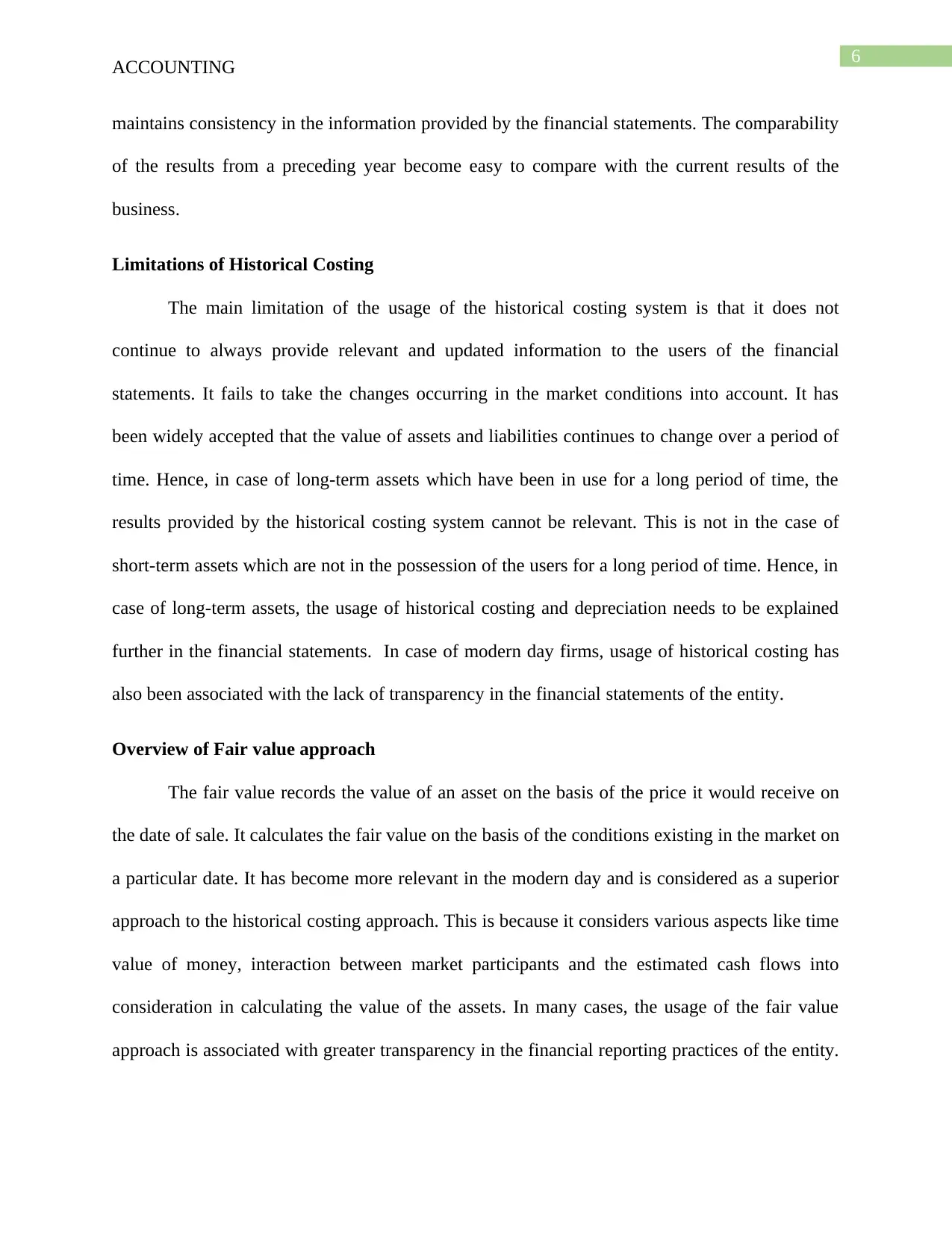
6
ACCOUNTING
maintains consistency in the information provided by the financial statements. The comparability
of the results from a preceding year become easy to compare with the current results of the
business.
Limitations of Historical Costing
The main limitation of the usage of the historical costing system is that it does not
continue to always provide relevant and updated information to the users of the financial
statements. It fails to take the changes occurring in the market conditions into account. It has
been widely accepted that the value of assets and liabilities continues to change over a period of
time. Hence, in case of long-term assets which have been in use for a long period of time, the
results provided by the historical costing system cannot be relevant. This is not in the case of
short-term assets which are not in the possession of the users for a long period of time. Hence, in
case of long-term assets, the usage of historical costing and depreciation needs to be explained
further in the financial statements. In case of modern day firms, usage of historical costing has
also been associated with the lack of transparency in the financial statements of the entity.
Overview of Fair value approach
The fair value records the value of an asset on the basis of the price it would receive on
the date of sale. It calculates the fair value on the basis of the conditions existing in the market on
a particular date. It has become more relevant in the modern day and is considered as a superior
approach to the historical costing approach. This is because it considers various aspects like time
value of money, interaction between market participants and the estimated cash flows into
consideration in calculating the value of the assets. In many cases, the usage of the fair value
approach is associated with greater transparency in the financial reporting practices of the entity.
ACCOUNTING
maintains consistency in the information provided by the financial statements. The comparability
of the results from a preceding year become easy to compare with the current results of the
business.
Limitations of Historical Costing
The main limitation of the usage of the historical costing system is that it does not
continue to always provide relevant and updated information to the users of the financial
statements. It fails to take the changes occurring in the market conditions into account. It has
been widely accepted that the value of assets and liabilities continues to change over a period of
time. Hence, in case of long-term assets which have been in use for a long period of time, the
results provided by the historical costing system cannot be relevant. This is not in the case of
short-term assets which are not in the possession of the users for a long period of time. Hence, in
case of long-term assets, the usage of historical costing and depreciation needs to be explained
further in the financial statements. In case of modern day firms, usage of historical costing has
also been associated with the lack of transparency in the financial statements of the entity.
Overview of Fair value approach
The fair value records the value of an asset on the basis of the price it would receive on
the date of sale. It calculates the fair value on the basis of the conditions existing in the market on
a particular date. It has become more relevant in the modern day and is considered as a superior
approach to the historical costing approach. This is because it considers various aspects like time
value of money, interaction between market participants and the estimated cash flows into
consideration in calculating the value of the assets. In many cases, the usage of the fair value
approach is associated with greater transparency in the financial reporting practices of the entity.
Paraphrase This Document
Need a fresh take? Get an instant paraphrase of this document with our AI Paraphraser
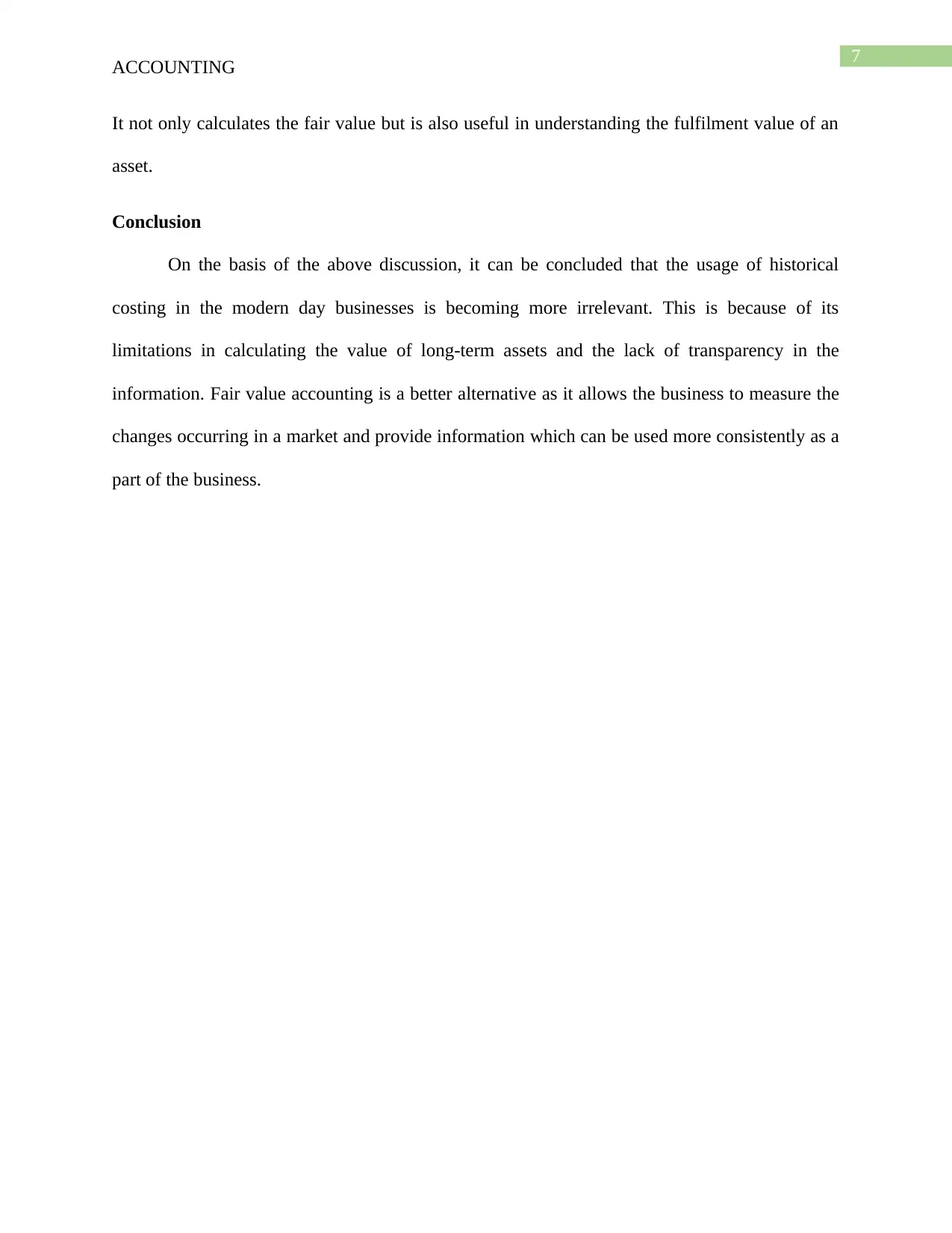
7
ACCOUNTING
It not only calculates the fair value but is also useful in understanding the fulfilment value of an
asset.
Conclusion
On the basis of the above discussion, it can be concluded that the usage of historical
costing in the modern day businesses is becoming more irrelevant. This is because of its
limitations in calculating the value of long-term assets and the lack of transparency in the
information. Fair value accounting is a better alternative as it allows the business to measure the
changes occurring in a market and provide information which can be used more consistently as a
part of the business.
ACCOUNTING
It not only calculates the fair value but is also useful in understanding the fulfilment value of an
asset.
Conclusion
On the basis of the above discussion, it can be concluded that the usage of historical
costing in the modern day businesses is becoming more irrelevant. This is because of its
limitations in calculating the value of long-term assets and the lack of transparency in the
information. Fair value accounting is a better alternative as it allows the business to measure the
changes occurring in a market and provide information which can be used more consistently as a
part of the business.
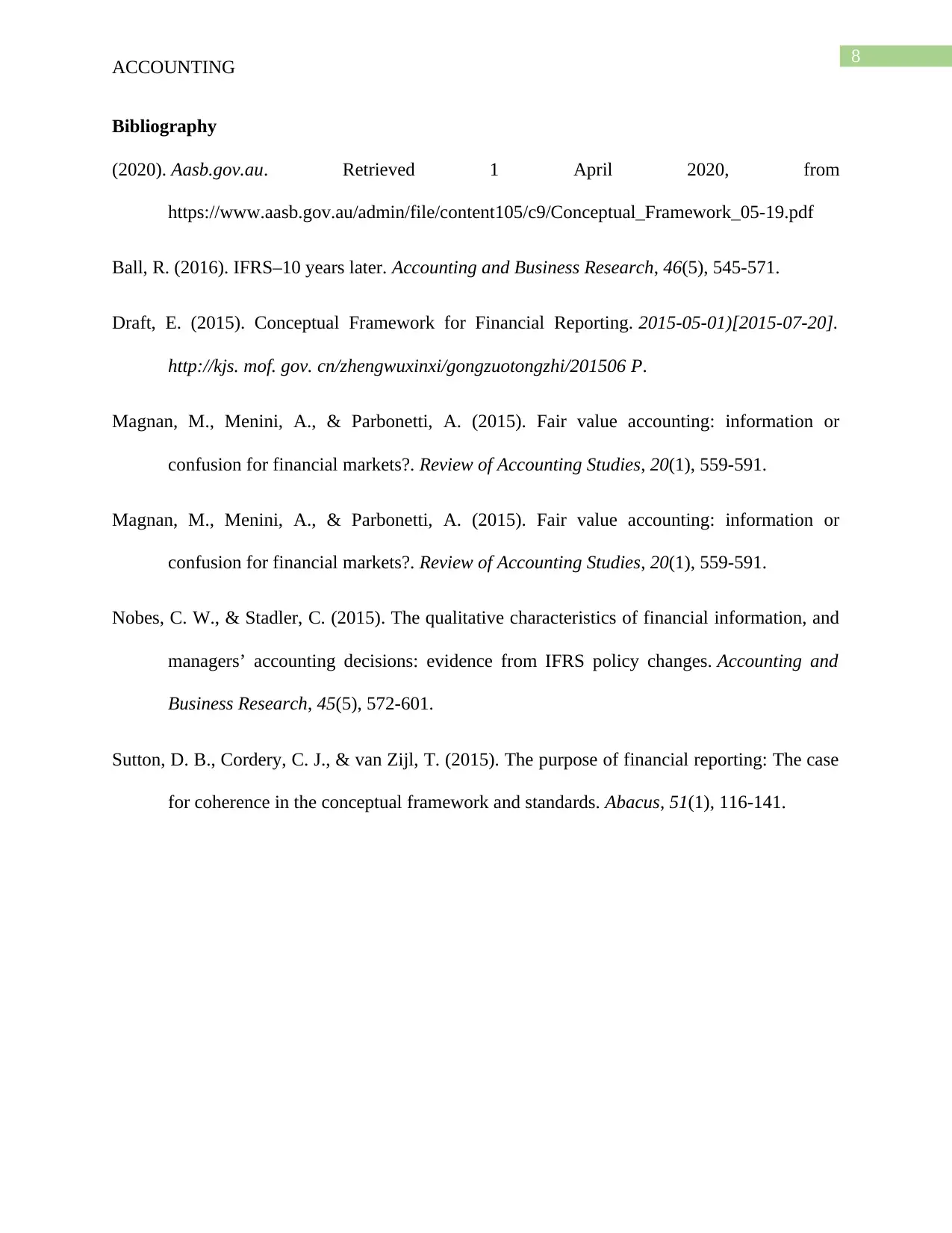
8
ACCOUNTING
Bibliography
(2020). Aasb.gov.au. Retrieved 1 April 2020, from
https://www.aasb.gov.au/admin/file/content105/c9/Conceptual_Framework_05-19.pdf
Ball, R. (2016). IFRS–10 years later. Accounting and Business Research, 46(5), 545-571.
Draft, E. (2015). Conceptual Framework for Financial Reporting. 2015-05-01)[2015-07-20].
http://kjs. mof. gov. cn/zhengwuxinxi/gongzuotongzhi/201506 P.
Magnan, M., Menini, A., & Parbonetti, A. (2015). Fair value accounting: information or
confusion for financial markets?. Review of Accounting Studies, 20(1), 559-591.
Magnan, M., Menini, A., & Parbonetti, A. (2015). Fair value accounting: information or
confusion for financial markets?. Review of Accounting Studies, 20(1), 559-591.
Nobes, C. W., & Stadler, C. (2015). The qualitative characteristics of financial information, and
managers’ accounting decisions: evidence from IFRS policy changes. Accounting and
Business Research, 45(5), 572-601.
Sutton, D. B., Cordery, C. J., & van Zijl, T. (2015). The purpose of financial reporting: The case
for coherence in the conceptual framework and standards. Abacus, 51(1), 116-141.
ACCOUNTING
Bibliography
(2020). Aasb.gov.au. Retrieved 1 April 2020, from
https://www.aasb.gov.au/admin/file/content105/c9/Conceptual_Framework_05-19.pdf
Ball, R. (2016). IFRS–10 years later. Accounting and Business Research, 46(5), 545-571.
Draft, E. (2015). Conceptual Framework for Financial Reporting. 2015-05-01)[2015-07-20].
http://kjs. mof. gov. cn/zhengwuxinxi/gongzuotongzhi/201506 P.
Magnan, M., Menini, A., & Parbonetti, A. (2015). Fair value accounting: information or
confusion for financial markets?. Review of Accounting Studies, 20(1), 559-591.
Magnan, M., Menini, A., & Parbonetti, A. (2015). Fair value accounting: information or
confusion for financial markets?. Review of Accounting Studies, 20(1), 559-591.
Nobes, C. W., & Stadler, C. (2015). The qualitative characteristics of financial information, and
managers’ accounting decisions: evidence from IFRS policy changes. Accounting and
Business Research, 45(5), 572-601.
Sutton, D. B., Cordery, C. J., & van Zijl, T. (2015). The purpose of financial reporting: The case
for coherence in the conceptual framework and standards. Abacus, 51(1), 116-141.
⊘ This is a preview!⊘
Do you want full access?
Subscribe today to unlock all pages.

Trusted by 1+ million students worldwide
1 out of 9
Related Documents
Your All-in-One AI-Powered Toolkit for Academic Success.
+13062052269
info@desklib.com
Available 24*7 on WhatsApp / Email
![[object Object]](/_next/static/media/star-bottom.7253800d.svg)
Unlock your academic potential
Copyright © 2020–2025 A2Z Services. All Rights Reserved. Developed and managed by ZUCOL.





